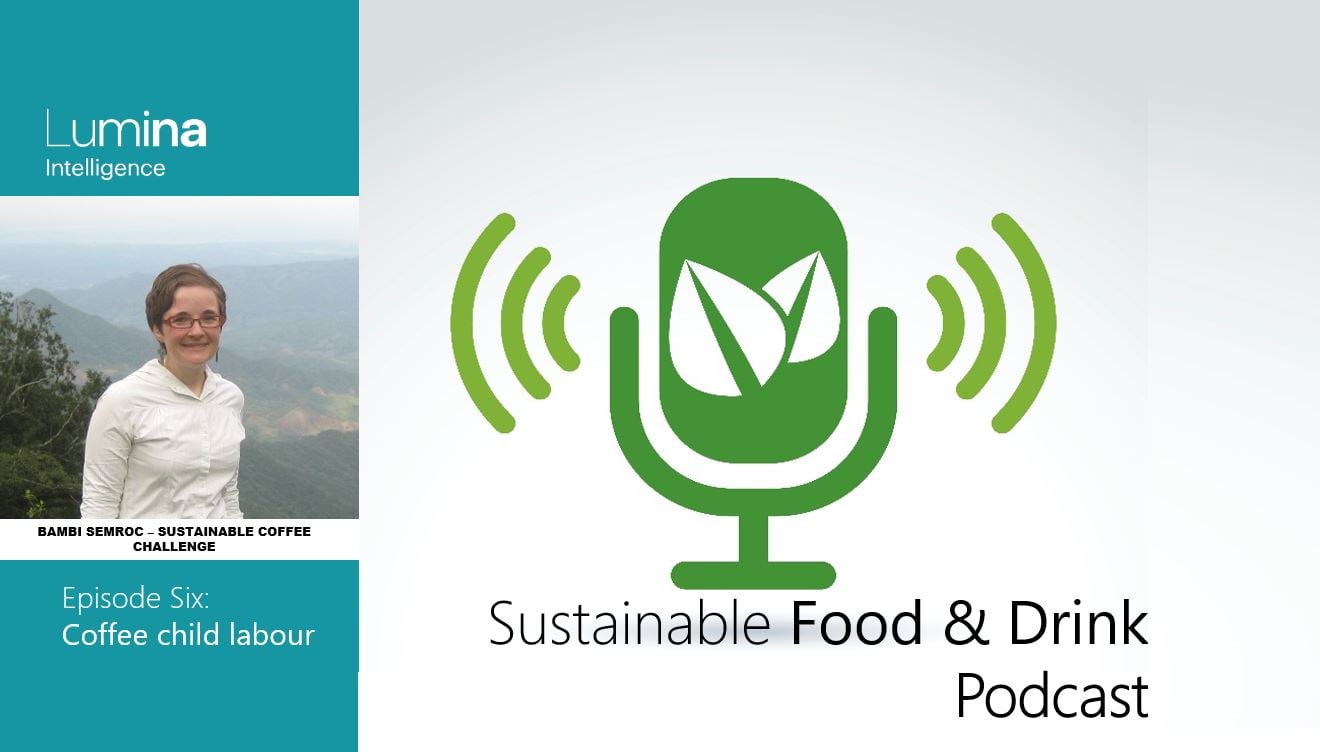US senators, documentary makers, researchers and multinational news corporations have rallied to highlight the worst forms of child labour in cocoa and chocolate.
But in coffee – another crop 90% grown by smallholders – research and publicity are limited.
A billion-dollar sustainability effort

Lumina Intelligence has identified 1.2bn investment on coffee-related initiates from the industry in initiatives aimed at reaching 803,000 farmers up to 2025.
Source: Food & Drink Sustainability 2019 - Global Progress Report
‘No campaign’
Speaking to Lumina Intelligence’s ‘Sustainable Food & Drink Podcast’, Bambi Semroc, vice president of sustainable markets and strategy at the Sustainable Coffee Challenge, said: “Sixteen of about 50 to 60 countries that produce coffee may have some risk associated with child labour.
But she said: “There’s no campaign in the coffee sector looking at labour.”
“…Perhaps it would help to get more investment and more things happening on the ground. It could be bad [that no campaign exists] in the sense that things might go undetected.”
The Sustainable Coffee Challenge –initiated by Conservation International and Starbucks, is aiming to get industry, governments and NGOs on the same page on how to address labour issues in coffee.
Seventeen at-risk countries
The US Department of Labor (DOL) says 17 coffee-producing countries have a risk of child labour – but there is limited other research.
This contrasts with cocoa where Tulane University been reporting on levels of child labour since 2008, in work commissioned by the DOL. The last report found 2.03m children engaged in hazardous cocoa work in the 2013/14 season.
Of the seventeen coffee-producing countries at risk of child labour practices, the DOL has statistics for only three countries:
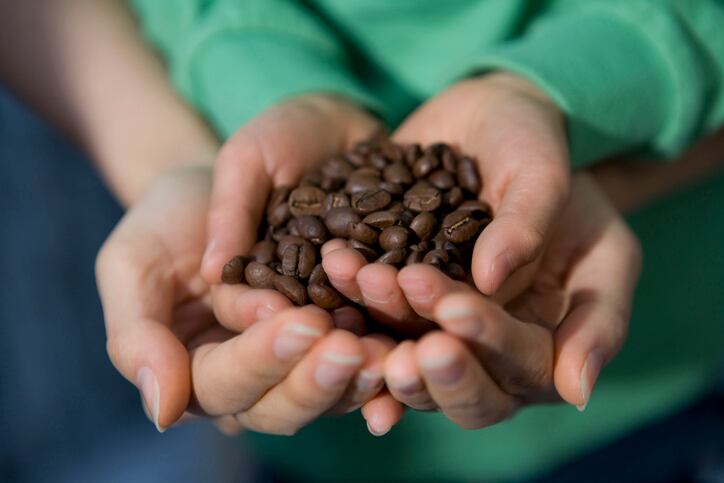
- The Government of Costa Rica’s 2011 National Household Survey (ENAHO), published in 2015, found 8.8% percent of child labourers in the country, around 1,422 children aged 5-14, were in child labour in coffee.
- Brazil’s 2015 National Household Survey estimated 4,993 child labourers cultivate coffee often without contracts or protective equipment.
- The Government of Vietnam’s National Child Labor Survey 2012, published in 2014, estimates 34,131 child labourers grow coffee. Around 37% of these child labourers are under 15, the country’s minimum age for employment.
- The DOL says there are also reports children aged 14-17 and younger in Côte d'Ivoire are forced to work on coffee plantations, sometimes forcibly transported from nearby countries such as Benin, Mali, Togo, and Burkina Faso.
Coffee has the third most child labour of all industries by number of at-risk countries, just behind cotton (18 countries) and sugarcane (19 countries), according to the DOL.
Migrant families picking coffee
Semroc suggested the area was under-researched because while 70-80% of cocoa grows in just two West African countries, coffee production is fragmented with five countries producing the majority and a speciality market drawing from 40-50 countries.
“Ninety per cent of farmers in coffee are smallholder farmers and that gives prevalence to family labour conditions,” she said.
“For a typical farm about 70% of the cost of production are labour costs. When you have low market prices you are going to have labour issues.
“You have migrant families coming during the harvest season to pick coffee. Some are coming with their families.
“Larger farms sometimes invest in day-care or creches for the children, but medium and small farms are going to struggle to have that expense,” she continued.
Certification gave sense of security
The Sustainable Coffee Challenge strategy chief said certification was prevalent in coffee and may have given the impression coffee volumes were verified and free from child labour.
Lumina research shows 24% of the bestselling coffee online across 20 countries makes a certification claim.
“That gave us a sense that things were OK,” said Semroc. “But what we’re seeing is that there’s still a lot of challenges.”
The Code of Conduct of 4C – the largest verification system in coffee by volume – says child work is only accepted as part of light family work outside schooling hours. It prohibits the worst forms of child labour.
Semroc said while certification standards have indicators on child labour, it’s mainly based on audits.
“Samples of farms are visited and audited once a year. You have eyes and ears of the ground once a year but not on a perpetual basis.
“Certification gives you a bit of risk assurance, but it’s not the same as having boots on the ground, she said.
Sustainable Coffee Challenge is advising companies to work with traders, extension agencies and local NGOs that can conduct more frequent visits.
Comparing industries: Monitoring in cocoa
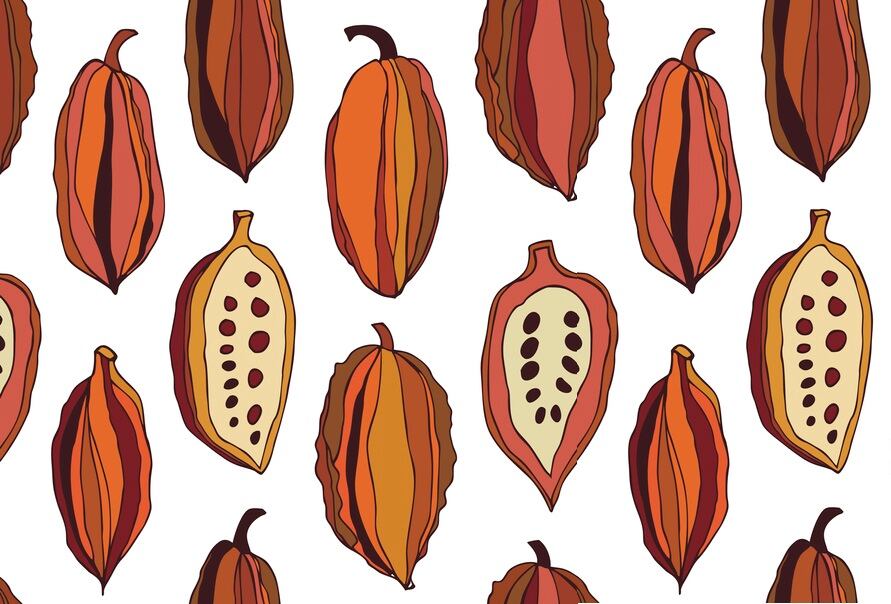
In cocoa, major players have embedded Child Labour Monitoring and Remediation Systems (CLMRS) into sustainability programmes. Under the system, a local person conducts household interviews around three times a year to identify child labour. An NGO partner then remediates cases - for example for providing a birth certificate allowing a child to attend school. Companies are even reporting the thousands of child labourers they are finding in supply chains.
Shouting from the rooftop
Semroc said 4C emerged in coffee in 2006 as a standard to eliminate practices such as child labour, while Rainforest Alliance and Fairtrade are also prominent certification standards in coffee.
Of the 79 coffee-related commitments tracked by Lumina Intelligence in the 2017 CSR reporting cycle, 22% of pledges were to source certified volumes.
“If you ask the industry if they had a commitment [on child labour] – they might say over 50% of coffee is verified according to one of these programmes that verifies these practices aren’t in their supply chains,” said Semroc.
“To them, it might feel they have a commitment [on child labour], but there’s not a commitment where the CEO is standing on the stage shouting from the rooftop,” she said.
Markets enabling profitability
A bumper crop in the main producing country Brazil sent arabica prices tumbling earlier this year, leaving some farmers earning less than $0.01 a cup, while Kenyan farmers produce coffee at a loss, according to a 2017 stud by Fairtrade and True Price.
Poverty in coffee
Coffee farmers in Uganda, Ethiopia, Tanzania and Kenya are furthest from achieving incomes above the extreme poverty line ($1.90), according to Lumina's analysis.
According to the Global Coffee Platform average farm sizes in Uganda (0.2 ha) and Ethiopia (0.5 ha) are far smaller than top producer Brazil (5 ha). Comparing GCP’s average net income per hectare with the UN’s data on average household size shows net incomes from coffee per household member are below the international extreme poverty line in Uganda ($0.05 a day) and Ethiopia ($0.14 a day). This excludes income from non-coffee sources. Truce Price estimates 50% of smallholder coffee farmer revenues, across seven analysed countries, come from coffee.
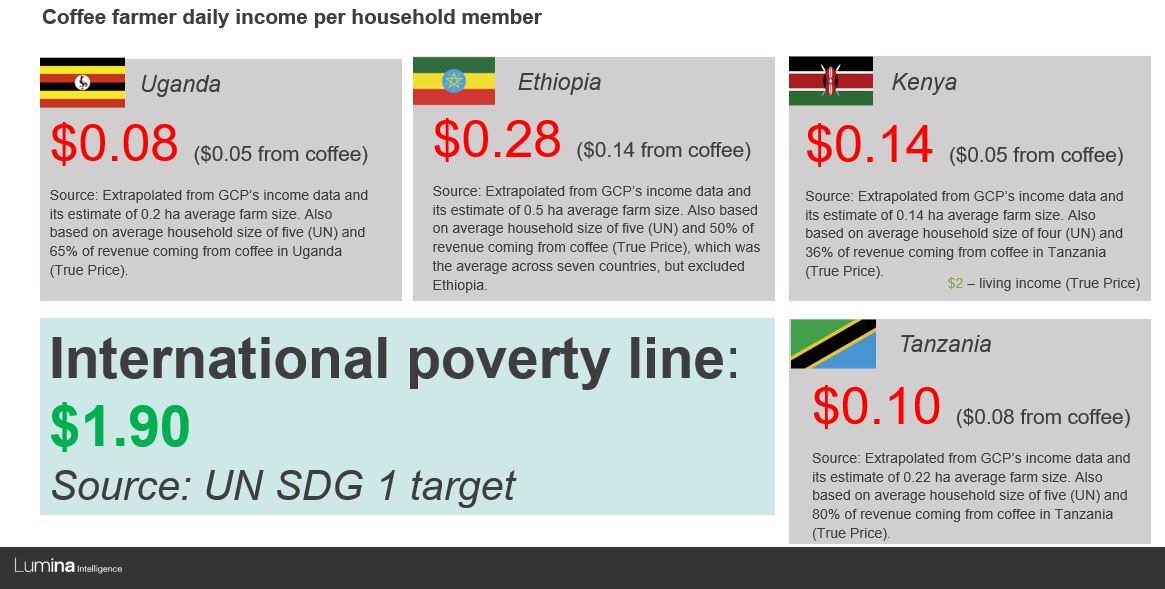
Source: Food & Drink Sustainability 2019 - Goal 1: No Poverty, Lumina Intelligence
“In terms of the price issue, the industry does need to create markets that actually work and enable profitability of coffee farms,” said Semroc.
She said climate change and price volatility could lead to further reliance on cheaper migrant labour to harvest coffee and a risk of child labour.
But she added that governments also need to create schools and services for children while parents are working.
“In places where you have mandatory education and schools available for children, you don’t run into this as much.
“We have to have more public-private partnerships to look at these issues together,” she said.
Semroc added a hard-line stance on having no children on coffee farms could be counter-productive as children may end up in even more dangerous situations
The Sustainable Coffee Challenge is trying to align its members on labour practices. It is looking at ways to monitor recruiters during harvest season, to crackdown on those that seek out children.
[Music credit: Blue Dot Sessions]
Sustainable Food & Drink Podcast - Lumina Intelligence
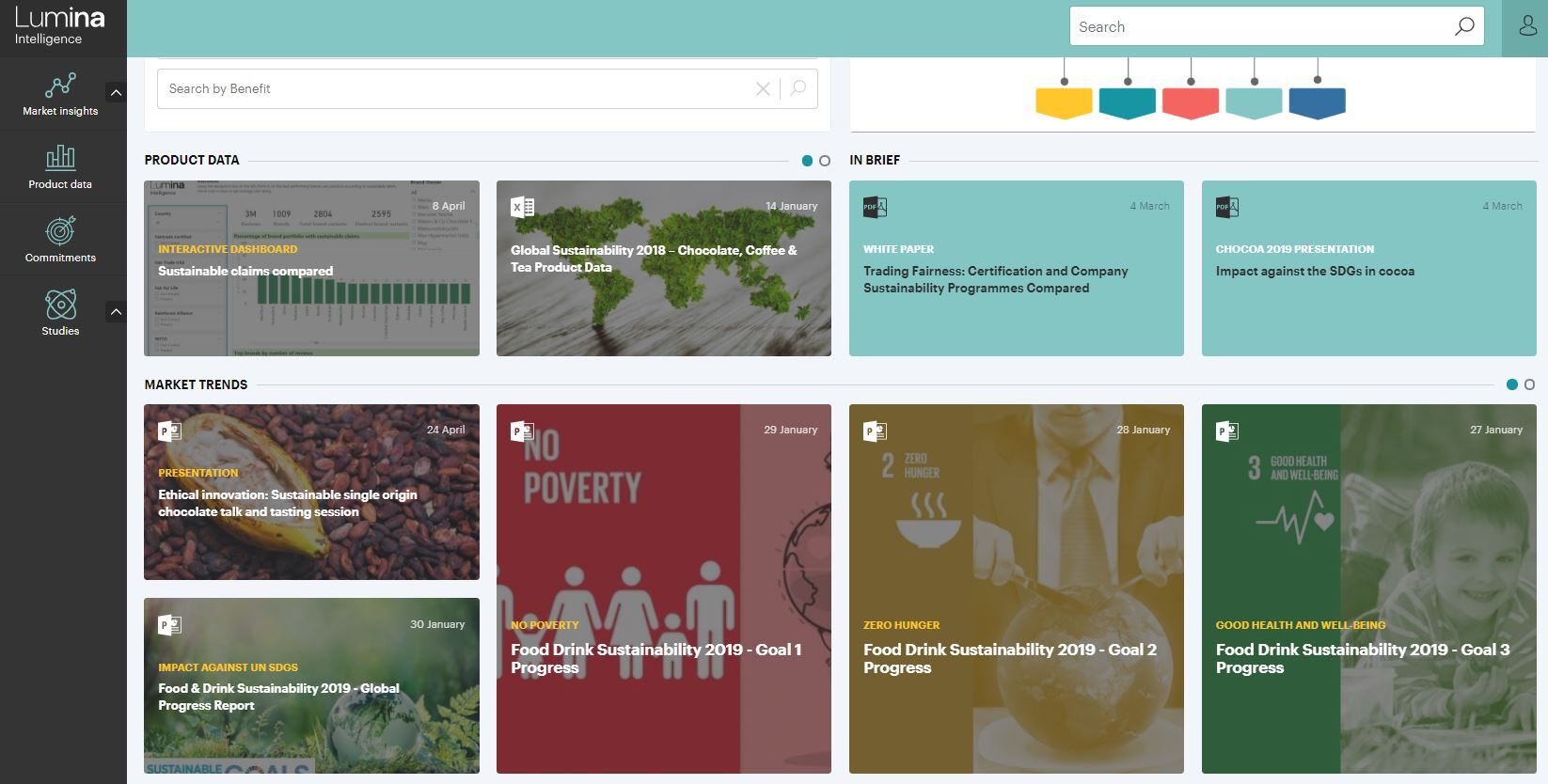
Lumina Intelligence Sustainability provides insights on the sustainable sourcing of cocoa, tea and coffee – three commodities facing similar social and environmental concerns.
The subscription service supports companies, suppliers, NGOs, governments and academics looking to strengthen their programmes, target research efforts and gauge demand for ethical products among online consumers. See website for further details.
Subscribe and Listen to Lumina's free Sustainable Food & Drink Podcast on iTunes & Spotify.

